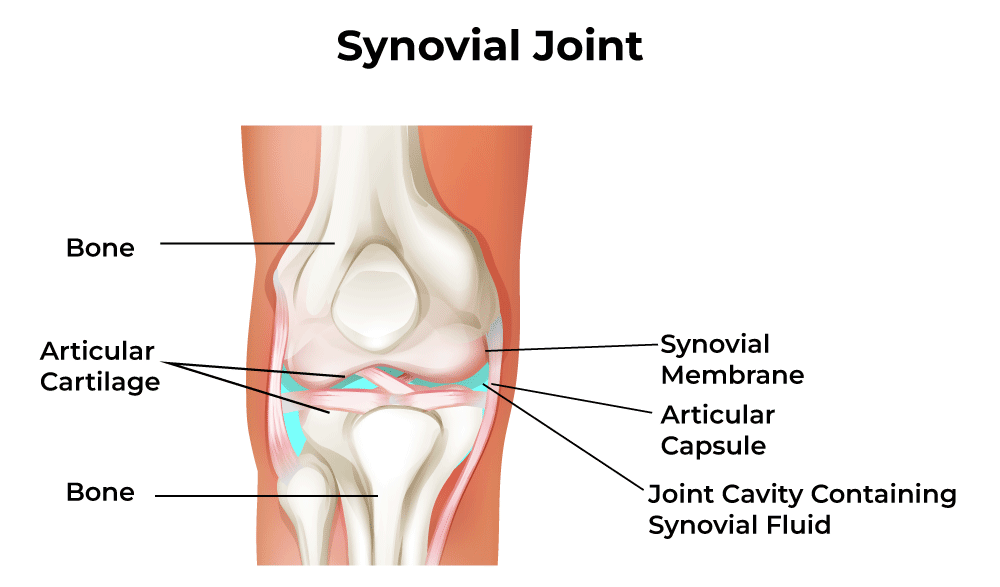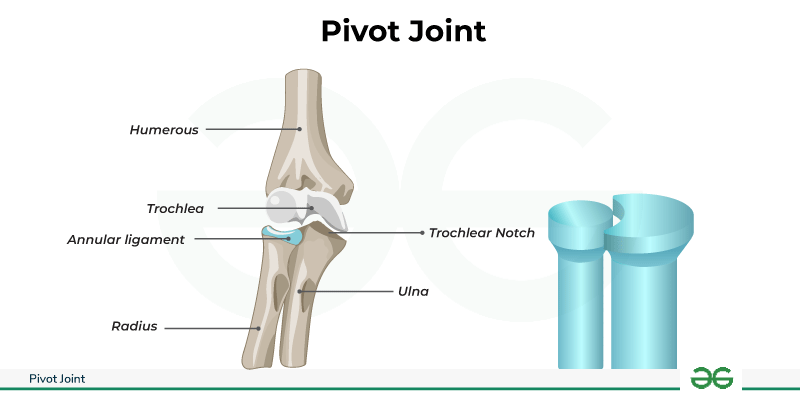The joints in human body are points of contact between bones or between bones and cartilage. The various types of joints in human body are classified into two groups based on structure and function. Joint enables movement and flexibility, allowing us to do simple tasks like bending fingers or complex ones like running and dancing.
Joints also help provide structural support and reduce friction while the skeleton moves. In this article, we will read about types of joints and their classification in detail.
What are Joints?
Joints, or articulations, are the points where two or more bones connect or meet in the body. Joints vary in structure, from immovable to highly mobile, depending on their location and function in the body. The importance of joints lies in their ability to facilitate movement, provide stability and support, distribute forces, enable weight-bearing, and allow a range of motion.
Classification of Joints in Human Body – (Types of Joints)
Joints can be classified into different categories based on their structure and the function they perform.
- On the basis of structure, the joint is classified into Fibrous joint, Cartilaginous joint, and Synovial joint
- On the basis of function, the joint is classified into: Synarthrosis, amphiarthrosis, and diarthrosis.

On the Basis of Structure
On the basis of structure i.e. based on the presence or absence of any supporting tissues or joint cavity, joints are classified into 3 types of joints:
Fibrous Joint
A fibrous joint is a type of joint where the bones are connected by fibrous connective tissue. The fibrous connective tissue in fibrous joints is composed of dense collagen fibers that bind the bones tightly together. Although the fibrous joint is known as an “immovable joint’ as it allows minimal to no movement, they are important for maintaining the integrity and stability of the skeletal system. Fibrous joints examples includes flat skull bones, rib cage, upper jaw, backbone, etc.
Also Read: Fibrous Joint

Cartilaginous Joint
A cartilaginous joint is a type of joint where the bones are connected by cartilage. The cartilage present between the bones in the cartilaginous joint is either hyaline cartilage or fibrocartilage. Although it provides less movement compared to synovial joints, its primary function is to provide structural support and shock absorption. These joints are essential in areas where flexibility is needed, such as the spine. Cartilaginous joint examples include the intervertebral discs between the vertebrae and the pubic symphysis in the pelvic region.
There are two types of cartilaginous joint
- Synchondroses: Temporary joints connected by hyaline cartilage, found in growth plates
- Symphyses: Permanent joints with fibrocartilage. examples include the pubic symphysis
Also Read: Difference Between Bone And Cartilage

Synovial joint
Synovial joints are the most common type of joint and are responsible for the majority of body movements. The joint is characterized by the presence of a synovial cavity, synovial fluid, and a joint capsule. Synovial fluid present in the synovial cavity acts as a lubricant, reducing friction and facilitating smooth movement. Synovial joints are surrounded by a joint capsule composed of fibrous connective tissue. Synovial joints enable a wide range of movements such as bending, straightening, rotation, gliding, etc. Example of synovial joints includes elbow, knee, hip, shoulder, wrist, ankle joint, etc.

Types of Synovial Joints
Synovial joints are of six main types based on their specific structure and range of motion:
- Ball and socket
- Pivot
- Saddle
- Condyloid or Ellipsoid joint
- Gliding joint or Plane joint
- Hinge joint
 Ball and Socket joint
Ball and Socket joint
A ball and socket joint is a type of synovial joint in which a rounded, ball-shaped end of one bone fits into a cup-like socket of another bone. This structure allows for a wide range of movement in multiple directions, including rotation, flexion, extension, abduction, adduction, and circumduction. The hip joint and the shoulder joint are examples of ball and socket joints in human body.

Diagram of Ball and Socket Joints
Pivotal joint
A pivotal joint allows rotational movement around a single axis. In pivotal joints, one bone rotates or pivots around another bone, resulting in movement. An example of a pivotal joint in body is the joint between the atlas (C1 vertebra) and the axis (C2 vertebra) in the neck.

Diagram of Pivot Joints
Hinge joint
A hinge joint allows movement primarily in one plane, similar to the action of a hinge on a door. It permits flexion (bending) and extension (straightening) along a single axis. The movement at a hinge joint resembles the opening and closing of a door. Hinge joints play an important role in various daily activities such as walking, running, and gripping objects. An example includes the elbow and knee joint.

Diagram of Hinge Joints
Saddle joint
A saddle joint allows movement in two planes flexion/extension and abduction/adduction, similar to the movement of a rider in a saddle. Saddle joints are characterized by the presence of two saddle-shaped surfaces, one convex, and the other concave. An example includes the joint at the base of the thumb.

Diagram of Saddle Joints
Condyloid Joint / Ellipsoid Joint
Condyloid joints are also known as Ellipsoid joints as they allow movement in elliptical manner. They allow movement in two directions, where an oval-shaped condyle of one bone fits into an elliptical cavity of another bone. Condyloid joints permit flexion and extension, as well as adduction and abduction, but they do not allow rotational movement. The condyloid joints example includes the base of the index finger and the carpals of the wrist.

Diagram of Ellipsoid Joints
Gliding Joint
A gliding joint, also known as a plane joint, is where the articulating surfaces of the bones are relatively flat or slightly curved. Gliding joints allow for gliding or sliding movements between the bones along various planes without significant angular or rotational movement. An example includes the wrists, ankles, and between the flat bones of the spine (vertebrae).

On the Basis of Function
The joints can also be classified into three types based on the degree of movement that the joints are allowed to show.

Synarthrosis/Immovable Joints
The joints that are immovable or nearly immovable are called synarthrosis. These joints are held together by dense fibrous connective tissue like collagen fiber that helps provide stability and structural support to the body and are held.
Examples of Types of Joints: Sutures of the skull, gomphosis of the maxilla and mandible, and synchondrosis of the epiphyseal plate in growing long bones.
Amphiarthrosis/Slightly Movable Joints
The joints that show limited movement are called amphiarthrosis. These joints are more flexible as compared to synarthrosis. They are connected by fibrous or cartilaginous tissues that provide it certain amount of flexibility to move.
Examples of Types of Joints: Syndesmosis of the tibiofibular joint, and symphysis of the pubic region.
Diarthrosis/Freely Movable Joints
The joints that are freely movable are called diarthrosis. These joints are characterized by the presence of a synovial cavity filled with synovial fluid that helps reduce friction for a smooth movement of the joints. They are capable of showing complex, multidirectional movements.
Examples of Types of Joints: hinge joints of the elbow, ball-and-socket joints of the shoulder and hip, pivot joints of the neck, saddle joints of the thumb, condyloid joints of the wrist, and gliding joints of the wrist and ankle.
Functions of Joints
The functions of joints are:
- They help in the facilitation of movement in the body.
- Provide stability to the skeletal system.
- They help absorb shocks to protect internal organs.
- Support to bear weight.
- They enable flexibility to the body for movement.
Conclusion – Joints-Types, and Classification of Joints
In conclusion, the joints in the human body play crucial roles in facilitating movement, providing stability, distributing forces, and enabling a range of motion. With various types of joints classified based on structure and function, joints allow us to perform both simple tasks like bending fingers and complex actions like running and dancing. Understanding the different types and functions of joints provides insights into their significance in maintaining overall bodily function and mobility.
Also Read:
FAQs – Joints-Types, and Classification of Joints
What are Joints in Anatomy?
Joints are a point that connect bones, provide support and stability, enable movement, absorb shock, and distribute forces during various activities.
What are the 3 Types of Joints?
On the basis of structure joints are of three main types; fibrous, cartilaginous, and synovial. However, on the basis of function joints are of three types; synarthrosis, amphiarthrosis, and diarthrosis.
What is the Classification of Joints?
Joints are classified on the basis of their structure (it consists of 3 types), and on the basis of function (it consists of 3 types).
What is Main Function of Joints?
The main function of joints is to enable the body to perform a wide range of activities while maintaining structural integrity.
How Many Joints are There?
There are around 360 joints in the human body that includes; 86 skull joints, 6 throat joints, 66 thoracic joints, 76 spinal and pelvic joints, 64 joints in the upper limbs, and 62 in lower limbs.
Share your thoughts in the comments
Please Login to comment...